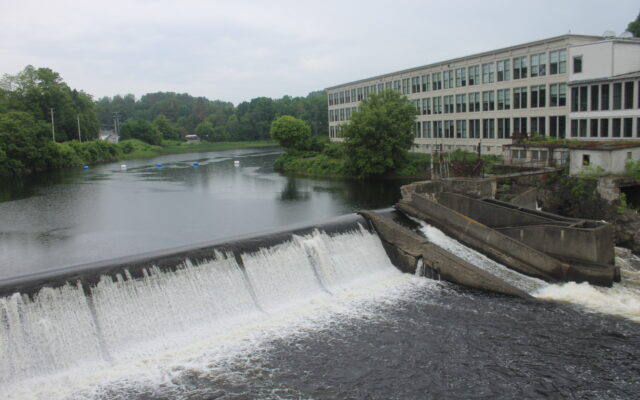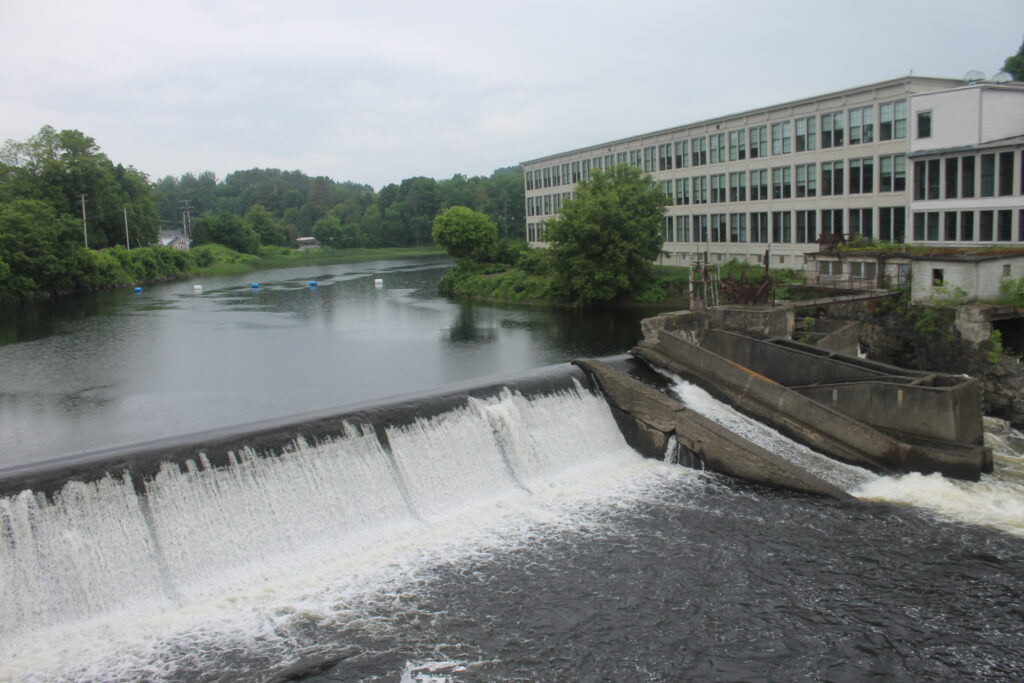
Dover-Foxcroft voted to keep its dam. Bigger tax bills may be next
DOVER-FOXCROFT — Dover-Foxcroft residents who were divided over the removal of the Mayo Mill Dam expressed elation, disappointment, and a mix of other emotions after Tuesday, June 11’s vote to keep it, but mostly they were full of questions about what will happen next.
Residents voted 558-411 to reject the dam removal article, meaning they were in favor of using tax money to fund studies, permitting, and repair costs for the dam.
On the other side, those who supported the article voted for the town to work with its partners to secure grant funding to remove the dam and develop a plan to restore the riverfront — an option that the town and a local committee endorsed, partly because funding is available for that kind of work.
Whether residents voted for or against dam removal, many wondered how much the dam repairs would really cost them and whether grant funding could lessen the impact on taxpayers despite the town warning that it would be sizable.

REMAINING DAM — Via a 558-411 referendum vote, Dover-Foxcroft residents voted to reject the removal of Mayo Mill Dam on the Piscataquis River, meaning they were in favor of using tax money to fund studies, permitting, and repair costs for the dam.
While the financial implications are hard to pin down because of variables such as the cost of repairs and length of repayment, the town is likely facing an $8 million to $10 million project, which would add 2 or 3 mills to the tax rate, Town Manager Jack Clukey said. That’s an additional “several hundred dollars a year” for the average taxpayer.
A resident with a home worth $200,000 would likely see an increase of about $600 to their tax bill, he said.
“The whole point of the recommendation was to offer a solution that would have the minimum burden on taxpayers,” he said. “Certainly, that’s what we want to see, and it’s going to be the focus of our discussions going forward.”
Despite the article failing, it drew more than 1,000 people to the polls, which was high for the town of more than 4,400 residents that historically has seen low turnout during its June election.
Clukey, who has led the town for about two decades, couldn’t recall the last time a local issue captivated so many residents. Whether they wanted to preserve the historic dam or embrace change, they asked questions and engaged in conversations, which he finds “encouraging.”
“I think everyone expected that it would be a close vote,” he said. “The biggest thing is that we had a lot of people participate.”
In the months leading up to the election, residents grappled with how dam removal could reshape the town, whose history is deeply intertwined with the Piscataquis River. Dover-Foxcroft’s character, access to nature and recreation, and the effect on taxpayers were among the factors they weighed.
The town committee that recommended in January removing the dam and building a riverfront park had spent more than a year looking for solutions to the aging piece of infrastructure and its connected facilities. It partnered with the Atlantic Salmon Federation, the Nature Conservancy in Maine and Inter-Fluve. Its report cited reducing flooding dangers, improving fish passage and funding for dam removal as reasons for its recommendation.
Janet Colbry was thrilled when she awoke Wednesday, June 12 to news that the dam would remain. She and a group of seven others, most of whom own property on the river, campaigned to “save the Piscataquis” and placed signs around town urging residents to vote down the article.
Colbry fought for the dam because she couldn’t stand the thought of seeing the river transform into a mudflat, similar to how it looks when the water gets low, she said.
The vote was personal, and in some respects, Colbry fought to keep the dam for her parents, who loved the river. She has lived on the Piscataquis for 64 years. Her grandchildren swim in and recreate on it, and she watches the otters and loons play in the water. Seaplanes land on the river in the summer.
“That river is one of the only redeeming features of this town,” she said. “It’s just part of our history.”
The election results didn’t shock Chris Maas, a member of the committee that studied the dam.
Although he initially couldn’t imagine seeing the dam removed, that was the solution he came to after going through the process, and he believed there was a way for a future park to honor the dam’s history, which dates back to 1807. It was originally built to power a sawmill and gristmill, long before Dover and Foxcroft combined into one town, and then was later rebuilt to power a woolen mill, shingle mill, tannery and iron foundry.
“What I wasn’t expecting was that it became such an emotional and partisan issue — that surprised me,” he said. “I’m comfortable knowing you live in a town, people get to vote and move on. That’s fair.”
He said the underlying issues that caused dam removal to come up, including failures to comply with the Federal Energy Regulatory Commission’s regulations, will not just disappear. The town must explore other options now that funding that its partners were confident they could secure is gone.
“We’re talking about $6 million to $10 million,” Maas said about the estimated cost for repairing the dam. “Where do we get it? How do we go about getting this done? That’s where we are.”
Colbry doesn’t want to see her taxes increase, but if they do, she is prepared to pay her fair share, she said. She refuses to believe there is no funding available to help the town cover expenses related to the dam.
The town heard from residents about programs that fund dam repairs and restoring hydroelectric power, but the Mayo Mill dam likely wouldn’t qualify for most because of its small size and low potential to generate electricity, Clukey said. He isn’t aware of funds “substantial enough to provide relief to taxpayers” who will have to take on a project costing millions of dollars. He also said the dam contributes to flooding of local infrastructure, which could hinder its ability to qualify for those funding sources.
Mary Annis, president of the Dover-Foxcroft Historical Society, was torn about the issue for months before the election, but she voted to keep the dam because the information presented by the town felt “one-sided” at times, she said.
“I don’t think anyone has really looked into it enough to satisfy me,” Annis said.
Joel Vail, the only Dover-Foxcroft Select Board member who voted in February against accepting the committee’s recommendation and sending it to voters, had similar reasons and heard from some constituents that the town was using “scare tactics” to get residents to support removing the dam. He is skeptical by nature and wishes research by other groups had been done, but “it was made clear that there is a chance our taxes will be impacted,” which was “common sense,” he said.
The only response to the town’s request for proposals to redevelop the dam site came from the Atlantic Salmon Federation and the Nature Conservancy. They agreed to partner in 2022.
Vail would like to see the dam repaired, operating again and eventually used to help the town during emergencies, such as dangerous storms that knock down power lines.
Maas isn’t sure the town voted to save the dam, but rather to “keep us from a headlong rush without considering other alternatives,” he said.